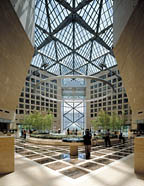
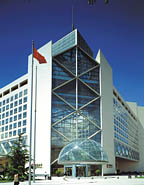
Beijing's height limits were imposed following architect I.M. Pei's first visit to the Chinese capital in 1974, when he urged authorities to protect the 800-year-old Forbidden City from encroachment by modern high-rises. Originally off limits to all but the imperial family and its entourage, this 8-million-square-foot walled palace (now a museum) comprises the oldest, largest and finest group of dynastic buildings in China. Its very essence depends on an intimate relationship with the open sky, one on one, to the exclusion of everything else. Pei's position was distinctly at odds with the prevailing climate in Beijing at the time. After decades of isolation, widespread destruction of the historic past had been eagerly undertaken in the name of progress. Preservation of this most precious cultural relic was the greatest contribution a native son could make to his mother country.
Twenty years later, 77-year-old I.M Pei paid a price for his altruism, when he joined with his sons -- C.C. Pei, 48, and L.C. Pei, 45, of Pei Partnership Architects (PPA) -- in accepting the commission to design the new headquarters of the Bank of China, just two blocks from the Forbidden City and neighboring Tiananmen Square. As a result of the restrictions that were enacted, the design had to accommodate the client's enormous 1.7 million-square-foot program on a 3-acre site, yet stay within the 135-foot height limit that Pei himself had championed.
To ventilate the mass, an 11-story, 32,500-square-foot "indoor public square" was carved from the heart of the headquarters. The distant origins of the atrium may be traced back thousands of years to China's traditional courtyard houses; more recently the idea has influenced other modern buildings -- mostly shopping centers -- in Beijing. But none compares even remotely in size, function or urban amenity. There simply is no precedent in China for a private building that so actively invites public participation; indeed, the whole premise of the design depends on it. Acceptance of the scheme required a very progressive change of attitude by the client regarding public/private space and the civic responsibility of corporate development.
Passers-by are encouraged to enter through monumental clear span entrances -- made possible by the largest box trusses in China -- and to angle through the atrium as a short cut between Xidan Dajie, a major shopping street, and Changan Dajie, Beijing's main ceremonial boulevard. The design is all about connection -- between different parts of the city; between the people and the institutions that serve them; and between the Bank of China and three generations of the Pei family in a country where lineage -- reinforced by Confucian thought -- is especially valued. Grandfather Tsuyee Pei was an influential administrator of BOC during its formative years in the early twentieth century. His son, I.M. Pei, designed the Bank of China Tower in Hong Kong in 1989, and now grandsons Chien Chung Pei, nicknamed Didi ("Little Brother"), and Li Chung Pei, known as Sandi ("Third Brother"), have accepted the baton from their father in executing BOC's new Head Office.
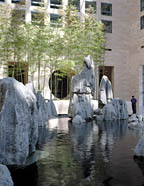
The Chinese garden
The most significant of the building's many connections is that between modernism and China's long and rich cultural heritage. Grounded in the belief that the future can only blossom from the roots of the past, the atrium of this highly sophisticated 21st-century building embraces a traditional garden. In so doing, it re-establishes the close relationship the Chinese have always had with nature. Unlike Western gardens, with their lawns and ornamental plantings, Chinese gardens seek to interpret the fundamentals of nature at a smaller scale in a three-dimensional portrait of water, rocks and plants. It is this aspect of the building that, according to the architects, accounts for its "Chinese-ness."The rocks at the Bank of China were secured by special government permission from the legendary Stone Forest in southwestern China. Myth has it that the immortals shattered a mountain to create this 198-acre maze of spiky stone formations in compassion for lovers seeking privacy. Geologists explain, in terms only slightly less extraordinary, that the area was formed in the Paleozoic era, when shifts in the earth's crust pushed great limestone masses up from the bottom of the sea. Over the next 200 million years, wind and rain eroded the range into towering sculptural peaks that today form one of China's most scenic national treasures. There are only two other places on earth where such fantastic formations exist, in New Guinea and Madagasgar, both in very remote areas.
Each rock was individually selected by Pei Partnership Architects, and then transported by train some 1,800 miles for installation in a 15-inch-deep, still water pool at BOC. The architects had to carefully position each 5- to 10-ton weight on one of the four giant post-tensioned girders that span over the bank's 2,000-seat column-free auditorium below -- the only place where so large a space would fit. Combining architecture, engineering, natural works of art and the artistry of man, the garden presents a harmonious balance of opposites. It is charged by the yin-yang contrast of rock against water; three-dimensional form against the pool's two-dimensional surface; opacity offset by transparency and watery reflections; permanence amid fluidity.
In Chinese gardens, wild nature is balanced by the control of that wildness by man. Nowhere is this clearer than in views of BOC's raw sculptural rocks against the atrium's precise ashlar walls. To the acute observer and open mind, the garden offers a layered metaphor to be contemplated and enjoyed, in tranquility, amid the noise and bustle of the surrounding city.
The atrium is protected by a space-framed skylight for year-round use. It provides a singular delight during the hot humid summers, which bring Beijing most of its annual precipitation; during its cold gray winters when Siberia air masses sweep in from the north; and during the fall and spring -- vibrant and clean -- when sands blow in from the Gobi Desert, seeping into crevices and covering the entire city in a fine yellow powder.
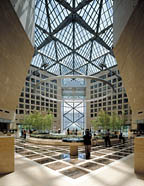
Choosing Italian travertine
The peacefulness of the atrium and the rich, almost magical, quality of its light, depend in large part on the Italian Roman classic travertine that defines the building inside and out. All of the stone was extracted from a single quarry by Mariotti Carlo & Figli Srl in Tivoli, Italy, and beautifully fabricated with the same honed finish. The interior and exterior thus share an unusual cohesion -- as if the entire building had been carved from a single block of stone as a piece of monumental sculpture.The buff-colored travertine was specifically selected to mask the airborne desert sands that are so evident on Beijing's mostly gray granite, brick and tile buildings. The great travertine mass emphasizes the permanence and stability of the bank as a stately landmark at a key downtown crossroads. At the same time, it reinforces the street wall and continues the distinctive character of Beijing as a city, which, like few others, has been defined historically by its walls. From its massive ring wall fortifications, which were demolished in the 1960s; to its many walled palaces, government compounds and temple precincts; and even to the walled hutongs (dense concentrations of one-story courtyard houses connected by narrow alleys), these elements still shelter a large portion of Beijing's population of 12 million.
The Bank of China is the first travertine building ever executed in Beijing. A variance was required because local classification considers travertine a marble, which is not approved for exterior use in Beijing's cold climate. Extensive testing was done to satisfy the objections of government officials more accustomed to the greater density of granite; travertine's characteristic pores were viewed as imperfections. The case was made with examples of buildings executed successfully in cold climate cities such as Moscow, Chicago, Minneapolis and notably New York, where Lincoln Center is clad in similar travertine.
In addition to travertine, the design of BOC incorporates other high-caliber Italian stone materials, which were supplied and fabricated by Furrer S.p.A. of Carrara, Italy, as well as natural stone from the U.S. and Spain. Moreover, the design includes more than 85,000 square feet of granite from Shandong Province of China, which was used to pave the wide sidewalks around the building, with other local stones used in restroom partitions and countertops
All of the stonework throughout the Bank of China was installed by Chinese workmen. Four different crews, one on each facade, worked virtually around the clock for six months to clad the headquarters by October 1, 1999, the 50th anniversary of the founding of the People's Republic. The accomplishment was remarkable, particularly since the stone was handset with only 8-mm joints (5 mm on the interior) by unskilled laborers from the countryside. It was all on-the-job training. The task was especially formidable as there was no local experience with a building of such precise detailing -- no notion of what the quality could or should be.
Throughout construction, BOC's walls were entirely shrouded in scaffolding and safety nets so the outcome could not be fully assessed until the very end. The result was "a beautiful surprise," according to Perry Chin, PPA's curtainwall consultant. "Seeing it for the first time was like looking at a miracle." Li Juan, the general contractor, explained with privileged insight and obvious pride how the casual visitor would admire the result but could "never appreciate how difficult it was to achieve the quality standards set by the architects."
The majority of the travertine was cut in 4- x 2-foot panels in accordance with the building's strict planning grid and for easy maneuverability by workmen. But the building also has many cubic yards of dimensional stone. Its walls are protected by 1- x 4-foot coping stones, and all exterior corners wrap around the edge to reinforce the building's sense of solidity. In the atrium, great blocks of dimensional stone are used in the stairs, information desks, seating and in the walls of planters that hold flowers or stands of giant bamboo as they discretely direct circulation through the space. Great moon windows provide serene garden views, like living paintings in beveled travertine frames.
On the atrium floor the painterly dimension is continued with Jet Mist granite panels which are framed in a travertine grid. Imported from Virginia, the granite recalls in its variable cloud-like patterning the impressionistic mountains of traditional Chinese landscape paintings. Other stone elements luxuriously accentuate the space. Rich chocolate-brown Emperador Dark Spanish marble enriches the banking hall floor above with a polish so high that it, like the garden pool, mirrors the atrium's skylight. Countertops are fabricated in deep green Verde Aceglio marble, as are the deal trays that sculpturally cantilever into the space. Other accents are called out in Botticino Classico and Verde Italian marbles.
Construction of the Bank of China began in 1995. Its site was cleared in much the same way it would have been centuries before, with donkey carts to haul away the rubble. Six years later, the building emerged as one of the most sophisticated and most superbly crafted in all of China.
Guided by Pei Partnership Architects' insistence on precision and by the widely perceived importance of the project, BOC's high quality became a source of national pride -- proof that in the impetus for modernization, "Made in China" would now be understood as a label of quality. The headquarters received a 2001 Tucker Award from the Building Stone Institute for excellence in the use of stone, and it was this kind of unique recognition that prompted the painstaking cleaning of the building's block-long facades. Each stone panel was washed by hand and every joint individually cleaned by workmen suspended on ropes from the roof in order to ready BOC for its official opening on June 27, 2001.
Tu Jian Ji, Chairman of Beijing Bank of China Building Co., Ltd., who oversaw the project, explained the challenges of realizing a building so richly dependent on balanced contrast. Fittingly, his comments are a weave of homespun and high-fashion metaphor. "It is like a fine suit," he said. "You need a gifted designer and quality materials. But, if you don't have a good tailor, the results will be unsatisfactory. The architect needs to know the strengths and weaknesses of the tailor. But challenge is good, as the stone installation shows. Now, because of this project, the masons will execute high-quality work elsewhere. The influence of the headquarters is not just in the building itself, but also in the field of construction. The standard of quality has been raised."
The new Head Office of BOC was one of only five buildings -- the only one by American architects -- selected by the government to represent national achievement during the recently celebrated fiftieth anniversary of Modern China. Municipal authorities are currently considering adding the building to the official list of tourist attractions in Beijing.
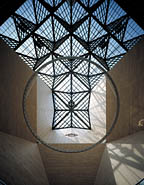
CREDIT BOX:
The Bank of ChinaHead Office
Beijing, China
Architect: Pei Partnership Architects, New York, NY
Stone Quarrier/Fabricator: Mariotti Carlo & Figli Srl, Tivoli, Italy (travertine)
Stone Supplier/Fabricator: Furrer S.p.A., Carrara, Italy
General Contractor: Li Jian
Curtainwall Consultant: Perry Chin